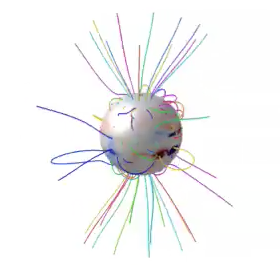Magnetized Plasma
Coordonator: Hinrich Lütjens
- Permanent staff:
Tahar Amari
Aurélien Canou
Anne Héron (%40)
Jean-François Luciani
Timothée Nicolas
- PhD student:
- Post-doc:
Research activities
The magnetized plasma group covers the numerical modeling of solar system plasmas as well as laboratory plasmas such as tokamaks or Hall-effect thrusters.
The astrophysical activity focuses on space plasmas in the solar environment, and also in the Earth environment when Earth/Sun interactions are considered.
The mechanisms associated with observed eruptive events are investigated. These studies are carried our using data stemming from current missions such as NASA’s Solar Dynamic Observatory, or future missions like Solar Probe or Solar Orbiter. Numerical codes exploiting this data and others allowed to study their evolution, at the scale of active centers in cartesian geometry with XTRAPOL and METEOSOL, or at a large scale in spherical coordinates with XTRAPOLS, or even multi-scale with MeshMHD.
This approach leads to the identification of the role of magnetic structures called « twisted magnetic ropes » and « magnetic cages » in the triggering of solar eruptions.
Thanks to its unstructured adaptive mesh, the MeshMHD code also allows to study the heliospheric environment at large scale as well as its interaction with planetary magnetospheres such as the Earth’s.
One of the goals is to study the mechanisms at the origin of the important temperature difference between the Sun’s surface (the photosphere) and the higher layers: the chromosphere and the corona, which are notably much hotter.
Tokamak thermonuclear plasmas are studied numerically using the XTOR code, in its fluid and hybrid kinetic/fluid versions. Macroscopic Alfvénic modes, which are observed experimentally, can be simulated, which allows to study in details the mechanisms of fast magnetic reconnection, or tearing instability of the magnetic surfaces. The hybrid fluid/kinetic version allows to understand the influence of hot ions (e.g.: fusion alphas or heating neutral beams) on the plasma stability, via resonances between the waves and the characteristic frequencies of ion motion in the torus. Collision phenomena are modeled in order to obtain the shape effects of the ion velocity distribution in a self-consistent way.
Finally, fully particular (Particle-In-Cell) simulations allow to study the mechanisms of anomalous electron transport through a magnetic field in Hall-effect ion thrusters. This anomalous transport is due to the nonlinear coupling of the electron cyclotron drift instability with the emission of secondary electrons at the thruster wall.
